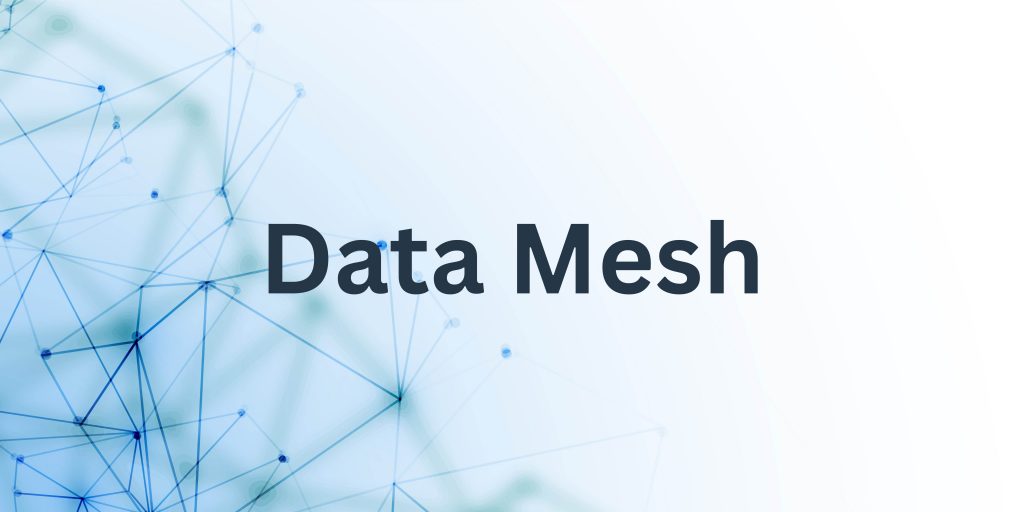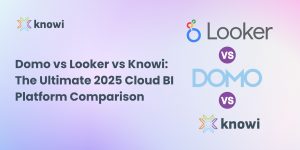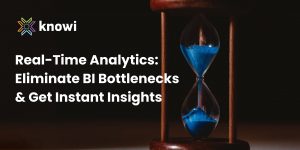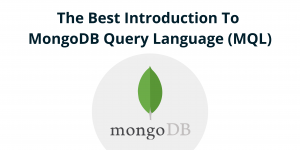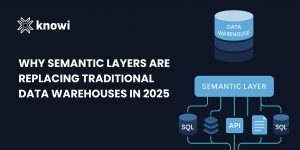In recent years, the data world has been abuzz with a new concept that has stirred both curiosity and innovation among organizations and technologists alike: Data Mesh. This emerging framework is reshaping how businesses approach data architecture, management, and analytics. Read on to know more about what data mesh is, why it is more relevant today, and how it is different from traditional approaches.
What is Data Mesh?
At its core, data mesh is not a technology, tool, or plug-and-play solution; it is a strategic framework designed to address the complexities of managing data at scale. The traditional centralized models of data management, characterized by siloed departments and a monolithic data team overseeing all integrations, are being reimagined with Data Mesh.
Data mesh proposes a decentralized approach where ownership and responsibility for data are distributed across various domains or departments within an organization, such as accounting, HR, operations, and finance.
This paradigm shift enables each domain or department to manage its data pipelines, create and maintain its data models, and perform analytics, all while contributing to a cohesive, interconnected data ecosystem. The central data team transitions from being the sole custodian of data logic and integrations to facilitating infrastructure and tools that empower domain teams to independently manage their data assets.
The term data mesh was coined by Zhamak Dehghani in 2019 and is based on four fundamental principles that guide its implementation:
- Domain-Oriented Decentralized Data Ownership and Architecture: Each business domain becomes the custodian of its data, responsible for its collection, processing, and availability. This principle ensures that data management is closely aligned with the domain’s specific needs and expertise, fostering faster decision-making and increased agility.
- Data as a Product: Data mesh advocates for treating data not as a byproduct of business processes but as a valuable product with defined customers (i.e., other domains or analytics teams). This approach necessitates a focus on data quality, usability, and accessibility, encouraging domains to provide data products that meet the needs of their consumers.
- Self-Serve Data Infrastructure as a Platform: To support decentralized data ownership, a self-serve data infrastructure platform is essential. This platform acts as the foundation for domain-owned data products. It empowers domain teams to build, manage, and deploy their data pipelines and APIs independently. The platform provides domain-agnostic functionalities like data processing tools and standardized workflows, enabling efficient data management. Crucially, this infrastructure enforces pre-defined rules and ensures data quality, security, and privacy compliance across the entire mesh. This approach fosters a balance between domain autonomy and centralized governance, allowing for increased agility in data product development while adhering to essential data management principles.
- Federated Computational Governance: While data mesh promotes domain autonomy, it also recognizes the need for overarching governance to ensure interoperability, consistency, and compliance across the organization. Federated governance models enable the balancing of local domain autonomy with global standards and best practices. Acting as a central body, the governance group sets the guidelines for all data products within the mesh. Standardization is key, ensuring that data from different domains can be seamlessly integrated and analyzed. The governance group fosters knowledge sharing and best practices, promoting a unified approach to data management across the organization. Crucially, this body also ensures adherence to both internal data policies and relevant industry regulations. This centralized oversight fosters a trustworthy and compliant data ecosystem, where diverse data products can flow freely and empower data-driven decision-making throughout the organization.
Why is a Data Mesh Required?
Data Mesh isn’t necessarily required for every organization, but it becomes increasingly valuable as data landscapes grow in complexity and scale.
As organizations scale, traditional data warehouses often become bottlenecks, struggling to handle the ever-growing volume and variety of data. The issue arises when this team is overwhelmed and unable to swiftly address the analytical inquiries from management and product owners. This bottleneck is a significant challenge, as the ability to make informed, data-driven decisions promptly is essential for maintaining a competitive edge.
The data team is eager to provide answers to business questions promptly. Yet, in reality, they find themselves struggling. A considerable amount of their time is consumed by the need to repair disrupted data pipelines caused by changes in operational databases. With the limited time that remains, they are tasked with identifying and comprehending the relevant domain-specific data. Additionally, to provide insightful answers to each business question, they must also acquire a deep understanding of the domain in question. However, gaining the necessary domain expertise often proves to be an overwhelming challenge.
Conversely, many organizations have embraced domain-driven design, forming autonomous teams focused on specific business streams or products, alongside implementing a decentralized microservices architecture. These domain-specific teams are experts in their areas, fully understanding both the operational needs and the data requirements of their domain. They independently develop, deploy, and manage their web applications and APIs. Despite their expertise and intimate knowledge of their domain’s needs, these teams often find themselves depending on the central data team for the vital data-driven insights required to make informed decisions.
As the organization expands, the strain on both the domain-specific teams and the central data team intensifies. The solution to this growing problem lies in transitioning the responsibility for managing and analyzing data from the centralized data team to the individual domain teams. This shift represents the essence of the data mesh concept: a move towards domain-oriented decentralization of analytical data management. By adopting a data mesh architecture, domain teams gain the capability to conduct their cross-domain data analyses, much like how they would interact with APIs in a microservices setup. This approach not only alleviates the pressure on the central data team but also empowers domain teams to leverage data more effectively and autonomously.
Its Core Components
1. Data Products: Data products are essential components within a data mesh architecture. They serve as logical units designed to process and store domain-specific data for analytical purposes. These products connect to various data sources, perform necessary transformations, and serve datasets through designated output ports. Examples of output ports include datasets in BigQuery and messages in Kafka topics. Each data product is owned and operated by a domain team responsible for its entire lifecycle, including monitoring data quality, ensuring availability, and managing costs.
2. Data Contracts: In the context of data mesh architecture, data contracts play a crucial role in facilitating data exchange between providers and consumers. A data contract specifies the structure, format, quality, and terms of use for exchanging data. It includes essential details such as the data product provider, usage terms, schema, quality attributes, service-level objectives, and billing information. By defining these parameters, data contracts ensure a common understanding of data semantics, quality expectations, and compliance requirements among all stakeholders involved in data exchange.
3. Federated Governance: Federated governance serves as the governing body responsible for establishing and enforcing global policies within a data mesh environment. These policies define rules and standards governing various aspects of data mesh operations, including data product development, interoperability, documentation, access control, privacy, and compliance. By establishing consistent policies across all domain teams participating in the data mesh, federated governance ensures alignment, coherence, and compliance with organizational objectives and regulatory requirements.
4. Transformations: Transformations represent the process through which data undergoes various stages of preprocessing, integration, and aggregation within a data mesh architecture. Raw operational data is cleaned, structured, and transformed into meaningful events and entities. External data from other teams is integrated, and aggregations are performed to derive actionable insights. These transformations are essential for maintaining data consistency, quality, and relevance throughout the data lifecycle, ultimately enabling informed decision-making and analytical insights.
5. Ingesting: Ingesting operational data into the data platform is a critical aspect of data mesh architecture. Domain teams employ various ingestion methods, including streaming ingestion, change data capture, or batch processing, depending on their specific requirements and use cases. Domain events and entity states are ingested to capture relevant business facts and maintain data integrity. Ingestion processes ensure real-time availability of data for analytics, reporting, and decision-making purposes, thereby driving operational efficiency and agility.
6. Clean Data: Clean data forms the foundation for effective data analytics and decision-making within a data mesh environment. Domain teams are responsible for cleaning and preprocessing ingested data to ensure accuracy, consistency, and reliability. Preprocessing steps include structuring unstructured data, mitigating structural changes, deduplicating entries, ensuring completeness, and fixing outliers. By ensuring data cleanliness, domain teams enhance the quality and reliability of analytical insights derived from the data, thereby enabling data-driven decision-making and organizational effectiveness.
7. Analytics: Analytics play a central role in extracting insights and value from data within a data mesh architecture. Domain teams leverage various analytical techniques, including SQL queries, data visualization tools, and machine learning methods, to gain actionable insights from analytical data. SQL queries facilitate data exploration, join operations, and aggregations, while data visualization tools enable users to visualize trends, anomalies, and key performance indicators. Machine learning methods support advanced analytics, correlation analyses, and prediction models, enabling organizations to derive valuable insights and drive informed decision-making.
8. Data Platform: The data platform serves as the backbone of a data mesh architecture, providing essential capabilities for data ingestion, storage, querying, visualization, and machine learning. Analytical capabilities enable domain teams to build analytical data models and perform analytics for data-driven decision-making. Data product capabilities empower domain teams to create, monitor, discover, and access data products in a self-service manner. The data platform also supports policy automation, cross-domain data access, and compliance management, ensuring efficient and effective data management and governance within the organization.
9. Enabling Team: The enabling team plays a crucial role in promoting and facilitating data mesh adoption within the organization. Comprising specialists with extensive knowledge in data analytics, engineering, and platform usage, the enabling team provides guidance, support, and learning materials to domain teams on their journey to become full members of the data mesh. They act as advocates for data mesh adoption, helping domain teams understand the principles, practices, and benefits of data mesh architecture. By fostering collaboration, upskilling, and knowledge sharing among domain teams, the enabling team accelerates the adoption and implementation of data mesh within the organization.
Implementing Data Mesh
Adopting a data mesh architecture requires a significant paradigm shift within an organization. This shift involves moving from centralized to decentralized data management, prioritizing domain expertise in data handling, and embracing a product-oriented view of data.
Here are the key steps and considerations for implementing a Data Mesh:
- Adopt Domain-driven Design
- Identify Domains: Break down the organization into distinct business domains based on the products or services it offers. Each domain should have a clear boundary and encompass a specific business capability.
- Domain Teams: Form autonomous teams around these domains, with the responsibility for their data, from production to consumption.
- Decentralize Data Ownership
- Data as a Product: Treat data managed by each domain as a standalone product, with a focus on quality, usability, and user needs.
- Domain Data Teams: Ensure each domain has a data team or data product owner responsible for the lifecycle of the data products, including their creation, maintenance, and retirement.
- Establish a Self-serve Data Infrastructure
- Platform Approach: Develop or adopt a self-serve data platform that enables domain teams to easily access, publish, and manage data products without deep technical expertise in data infrastructure.
- Tools and Technologies: Provide tools for data ingestion, processing, storage, and access that support a wide range of data product types and needs.
- Implement Federated Computational Governance
- Governance Framework: Create a federated governance model that balances autonomy with coherence. This involves setting cross-domain standards and policies for data security, privacy, quality, and interoperability.
- Compliance and Standardization: Ensure that while domains operate independently, they adhere to organizational standards and legal regulations.
- Embrace Data Product Thinking
- User-centric Design: Design data products with the end-user in mind, focusing on ease of discovery, access, and integration.
- Quality and Documentation: Prioritize data quality and provide comprehensive documentation to ensure data products are trustworthy and easily understandable.
- Cultivate a Culture of Collaboration
- Cross-domain Collaboration: Encourage and facilitate collaboration between domain teams to share best practices, learnings, and data products.
- Continuous Learning: Foster a culture of continuous improvement and learning, where feedback from data consumers drives the evolution of data products.
- Technological Foundations
- Interoperability: Adopt technologies and standards that promote interoperability among data products across domains.
- Scalable Architecture: Ensure the data architecture is scalable and flexible to accommodate future growth and changes in business requirements.
- Continuous Monitoring and Feedback Loops
- Monitoring: Implement monitoring tools to track the usage, performance, and quality of data products.
- Feedback Loops: Establish mechanisms for collecting feedback from data consumers to continuously improve data products.
- Training and Education
- Upskilling: Offer training and resources to domain teams to build their capabilities in data management, governance, and product development.
- Best Practices: Share best practices and lessons learned across the organization to elevate the overall data literacy and maturity.
Implementing a Data Mesh is a significant undertaking that requires commitment from all levels of the organization. It’s not just a technical implementation but a new way of thinking about and working with data.
Data Mesh vs Traditional Model
Transitioning from traditional pre-data mesh governance to a data mesh governance model marks a significant shift in how organizations approach data management. In the pre-data mesh era, a centralized team was tasked with overseeing data quality, security, and compliance with regulations, maintaining centralized custodianship of data, and striving for a well-defined, static structure of data governed through manual processes aimed at preventing errors. This team also worked independently from domains, using centralized technology and measuring success based on the volume of governed data.
Contrastingly, the data mesh governance model introduces a federated team composed of domain representatives, responsible for defining the criteria for data quality, security aspects, and regulatory requirements, which are then built into and monitored by a self-serve platform.
This model champions federated custodianship of data, with a focus on modeling polysemes—data elements that span multiple domains—thus enabling a dynamic, continuously evolving topology of the mesh. Success in this model is measured by the network effect, illustrating the connections and consumption of data across the mesh, with an emphasis on detecting errors and enabling recovery through the platform’s automated processes. This shift not only democratizes data management but also promotes a more agile, responsive approach to data governance that aligns with the fluid nature of modern data landscapes.
Conclusion
As the data landscape continues to evolve, data mesh offers a forward-thinking framework that aligns with the needs of modern, data-driven organizations. By decentralizing data ownership, treating data as a product, and fostering a culture of collaboration and innovation, companies can unlock new levels of efficiency, agility, and strategic insight. While the journey to a fully realized data mesh architecture may be complex and challenging, the potential rewards for those who navigate it successfully are substantial. As we continue to witness the adoption and adaptation.
